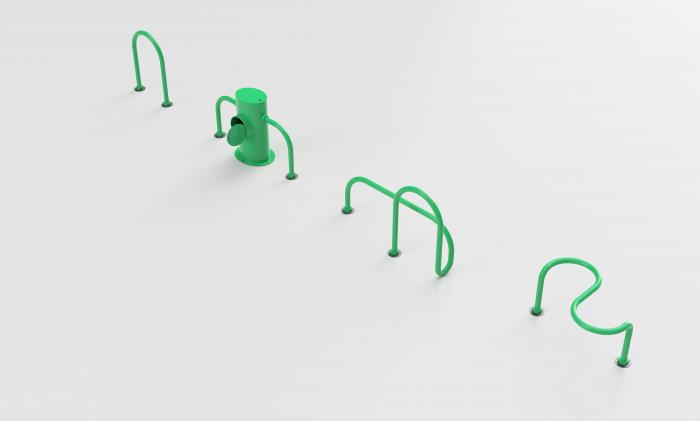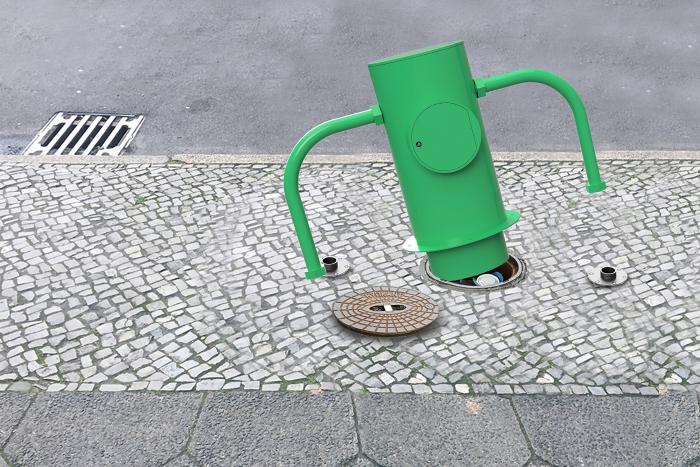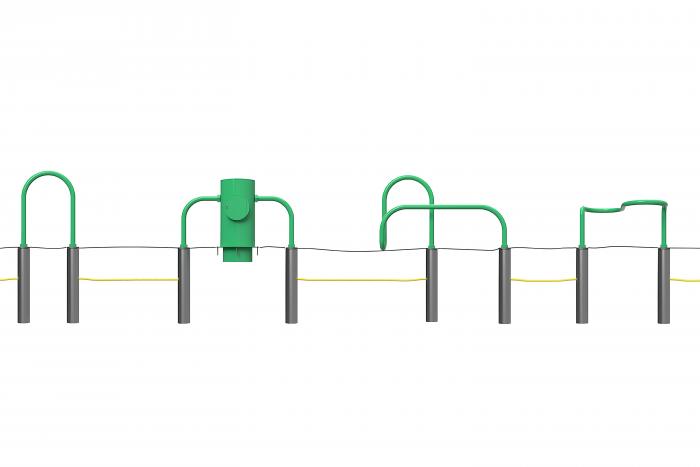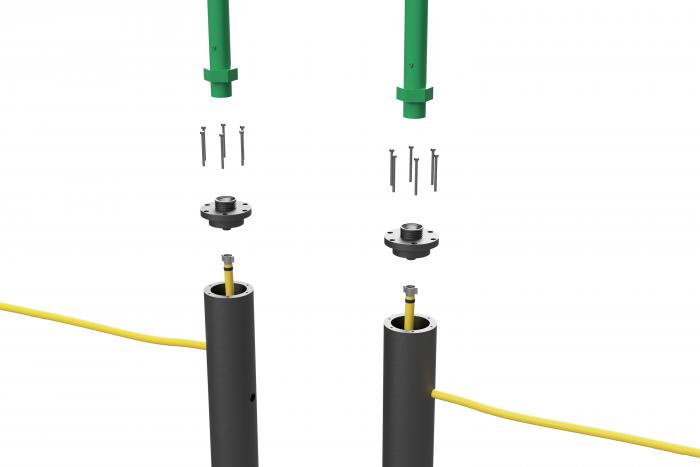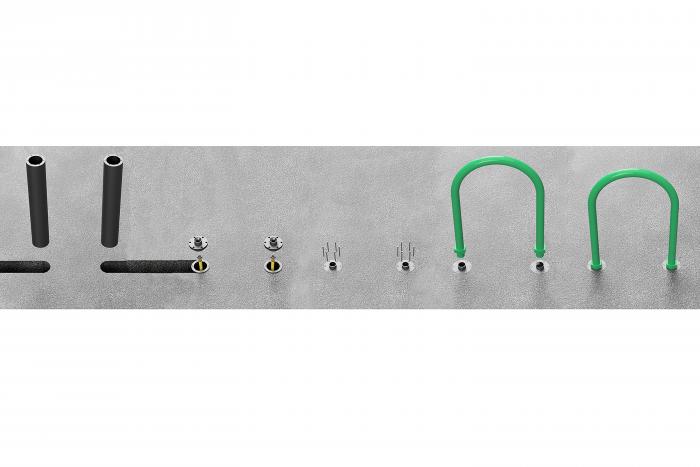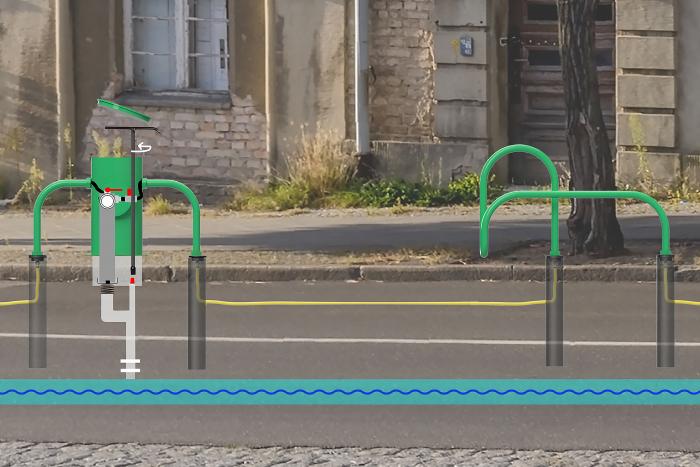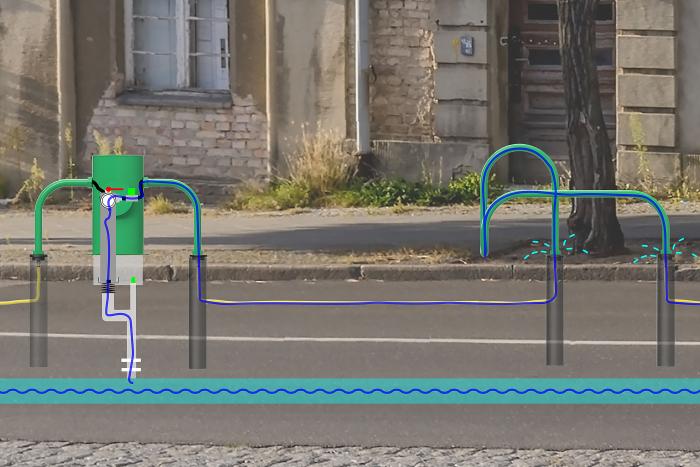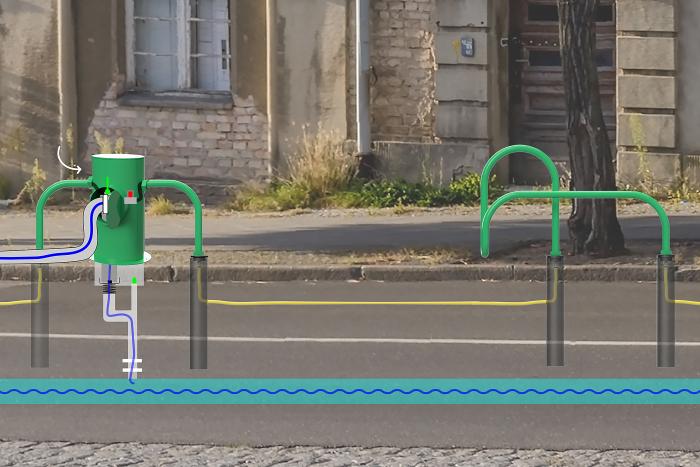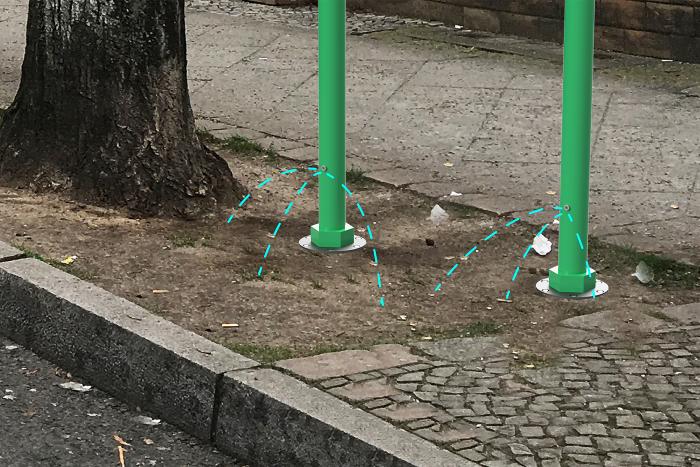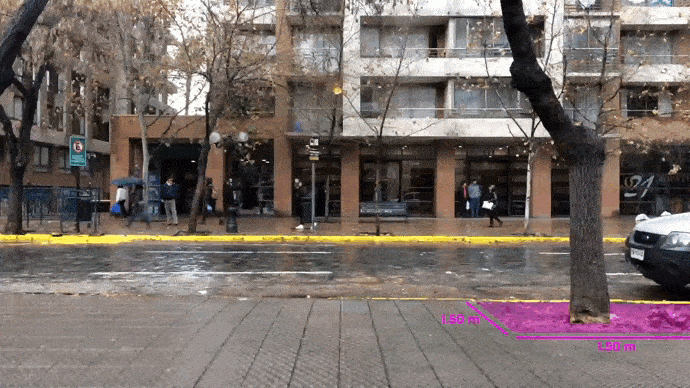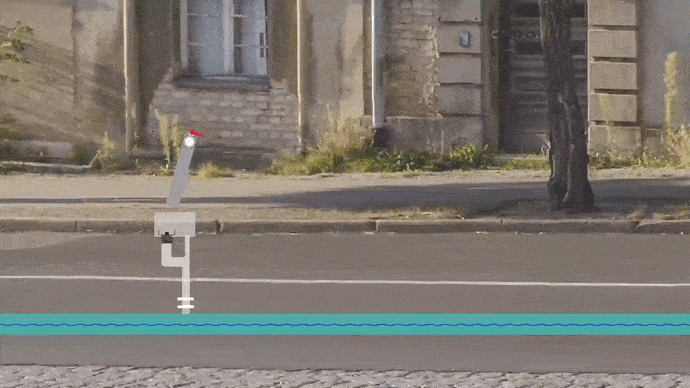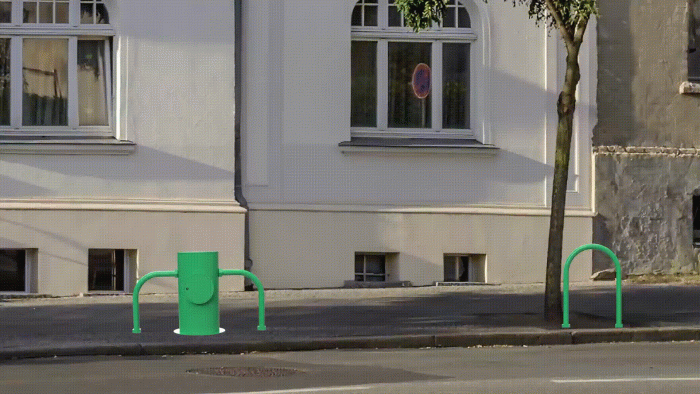I. SUMMARY INFORMATION
Project
268414
Status
Submitted
Award category
Products and life style
You want to submit
NEW EUROPEAN BAUHAUS RISING STARS : concepts or ideas submitted by young talents (aged 30 or less)
Project title
NESSI
Full concept/idea title
NESSI – Saving Urban Greens
Description
Can’t we give our trees a hand?
NESSI contributes to the saving of urban greens tackling the draught of city trees with an irrigation system on pavements that makes use of the existing infrastructure of hydrants.
From the hydrant, water is automatically directed through NESSI's pipe under the pavement to the trees, watering city trees with small water reservoirs regularly. At the trees, NESSI pops up with colorful steel pipe objects that offer different usage possibilities for residents.
Where is your concept/idea being developed or intended to be implemented in the EU?
Germany
Berlin
Hermannstrasse 231
Berlin
12049
II. DESCRIPTION OF THE PROJECT
Please provide a summary of your concept/ idea
There is an enormous public demand for cities to have a high-quality and sufficiently dimensioned green infrastructure as greens counteract the urban heat-island effect and provide fresh air particularly to dense areas.
In Berlin, 430 000 city trees are located. Over the last two years, 7000 of these trees have died as a consequence of drought.
Too small tree grates are a significant reason for city tree drought. The down seeping water flows through the surface to the roots. In Berlin, tree grates typically only measure 1.50 by 1.50m. Forest trees, by comparison, have the area of their crowns irrigated when raining– this is around 10 times greater.
Under these circumstances, city trees, on pavements especially, are only able to store minimal water and can’t photosynthesise properly. The additional burden of climate change, like more frequent heat waves, leads to decreased biomass and leaves and subsequently to the death of the trees.
At the same time, there is a functioning water cycle system under Berlin’s pavements. Underground hydrants provide access to the supply lines and are located next to the trees. To stay fit, the city’s water cycle system and hydrants should be used regularly.
Can’t we give our trees a hand? How can we see, use and share local resources?
NESSI contributes to the saving of urban greens tackling the draught of city trees with an irrigation system on pavements that makes use of the existing infrastructure of hydrants.
To share the water, NESSI docks to a hydrant and winds its way through Berlin’s streets from bottom to top. From the hydrant, water is automatically directed through NESSI's pipe under the pavement to the trees, watering city trees with small water reservoirs regularly and self sufficiently, . At the trees, NESSI marks the trees that are part of the network and pops up with colorful steel pipe objects that offer different usage possibilities for residents.
Please give information about the key objectives of your concept/idea in terms of sustainability and how these would be met
1.Environmental objective:
Tackling the urban heat island effect and global warming:
NESSI tackles city tree drought with a sustainable irrigation solution and a soil-enhancing measure ensuring the longevity and health of urban trees and thus the air purification in urban spaces. Regular, optimised irrigation increases the pore space and rooting depth of urban trees with small water reservoir, increasing the evaporation and cooling capacity of urban soils. The healthy trees reduce the air temperature by evapotranspiration and carbon fixation counteracting the urban heat-island effect and global warming.
2. Economical objective:
Seeing and using local resources, connecting to existing infrastructures: Intensifiying the use of the existing infrastructure of hydrants, NESSI sees local resources and turns monofunctional hydrant into multifunctional city objects: they are available to the fire brigade for fire-fighting operations, but are now additionally the key link between NESSI and the supply line system for watering urban trees. They are unaffected by NESSI and even easier accessible to firefighters in emergency situations. Through regular flushing, NESSI keeps hydrants also in good condition.
Influence on the industry: NESSI takes on a fixed responsibility for the care of urban trees. Urban trees can thus exist more and more self-sufficiently from residents or infrastructure companies watering the trees.
Reparability: The steel pipe objects are mounted above ground and can be regardless of accidental or purposeful damage, once installed, easily changed.
3. Social objective:
Sharing resources for the common good: NESSI wants to prove that trees are indispensable and that any investment is justified.
Quality of life in public space: The use of the NESSI objects, such as seating, and the shade provided by the trees contributes sustainably to the quality of life on the streets.
Raising collective awareness: signal for the saving of urban trees and collective care
Please give information about the key objectives of your concept/idea in terms of aesthetics and quality of experience beyond functionality and how these would be met
What effects should objects in our environment, especially in public space, have on us as residents and on us as a community?
1. Generating welll-being and quality of life:
High-quality green infrastructure in the streets of city centres provide health and diversity. The use of the NESSI objects, such as seating, and the shade and greens provided by healthy trees contribute to the quality of life in the streets.
2. Promoting participation and access to public space:
Public space has an important role in a global community. Outside of private spaces, people meet and gain the awareness of being part of something bigger. This is a key aspect of global thinking. NESSI shapes and reevaluates public space and offers opportunities for use, thus increasing the attractiveness of public space.
3. Creating Urban artefacts that grow out of current challenges and seem relevant to us:
In a world of infinite production, the relevance and sustainability of a product play a major role to us. Tackling a current challenge in Berlin, NESSI wants to act from relevance. The NESSI objects should be understood and seen as an urban artefact that marks cities that engage in tackling city tree drought.
4. Adding iconic and stylish urban artefacts shaping public spaces visually:
The colorful steel pipe NESSI objects catch the eye and attract attention. The figurative design moves away from the classic fitting and shows a new look in the world of urban artefacts.
5. Creating joyful experiences with impact:
Popping up at the trees and watering above ground, NESSI enables residents to see and experience the funds for the improvement in the quality of life. Noticing and understanding how often the trees get watered, residents experience a learning effect.
Please give information about the key objectives of your concept/idea in terms of inclusion and how these would be been met
1. Addressing an issue where everyone is equally affected by both the problem and the impact:
NESSI deals with the burden of climate change- the urban heat island effect and subsequently with city tree drought- making a (2.) local change for a global impact: Contributing to the saving of local urban greens to counteract the urban heat-island. Watering city trees regularly is a local action with a collective goal.
3. Designing systems of living and non-living elements:
NESSI includes the existing infrastructure of hydrants and builds up a system and communication between hydrants and trees.
4. Universal Design Thinking:
The social, environmental and societal developments as the basis of the design process. Innovative development of products or even services from which not only benefit many people, but also our environment. NESSI recognises that in order to sustainably enjoy the benefits of green infrastructure, we need to focus also or even first on the needs of the trees.
5. Democracy in public space:
Public spaces – streets, parks and squares – played a major role in the development of democracy, serving as places where anyone, regardless of income or position, could meet. For diversity, it’s crucial to start to involve, plants and animals in public space. Nessi gives trees the right for space and care in public life.
6. Extended community building:
Caring for trees clarifies, educates and generates an extended community of people and trees, in which each side benefits symbiotically from the other.
Besides, NESSI confirms the existing community of a participatory society in berlin that like to contribute collectively to global impacts.
Please explain the innovative character of your concept/ idea
So far, there are no conventional solutions on the market for systematic and automatic watering of urban trees on pavements, apart from manual watering. NESSI waters trees with small water storage regularly, automatically and optimised. The principle used is an automated irrigation system from horticulture. It can be adjusted via an irrigation computer located in the object above the Hydrant. The adjusted setting determines when and how much the trees should be watered. Urban trees can thus exist more and more self-sufficiently from residents or infrastructure companies with the certainty of not being at the mercy of dryness.
The docking and dual use of hydrants is a simple but effective approach. NESSI hacks the system of hydrants and gets access to a sufficient quantity of water without having to extend an own network of pipelines deep below the ground.
The innovative character of the project lies in the combinations and connections of different systems and principles that already exist and in their transformation into an appealing accessible object for the urban space.
Please detail the plans you have for the further development, promotion and/or implementation of your concept/idea, with a particular attention to the initiatives to be taken before May 2022
NESSI should be tested and seen in action. I would like to use the prize money to have at least one set produced and installed. I see the Karl Marx Strasse neighbourhood in Berlin Neukölln, for example, as a location for a pilot project. Here happens an extensive redevelopment work and an upgrading of the neighbourhood. They ask for participation and new ideas from the residents for the urban space.
Once installed, I would like to observe and document the functionality and effects of NESSI. In summer, I want to create new image and video material for promotions.
Having new footage, NESSI will be sent to various design magazines and should be communicated as a product for urban planners and landscape architects for upcoming projects.
1. Production of one set at a factory:
Steel pipe objects: 1. Bending steel tubes (60.3 mm x 3.2 mm), 2. Screwing holes for nozzles, 3. powder coating (PANTONE 16–6240 TCX)
NESSI object: 1. cutting steel sheets (4 mm sheets), 2. bending and welding cutted steel sheets, 3. add threads, 4. powder coating (PANTONE 16–6240 TCX), 5. add locks
Underground system: pouring foundation tubes, remaining parts are prefabricated parts
According to an enquiry in a workshop in Berlin, the production of a set costs about 1000€.
2. Pilot project in Berlin- Karl-Marx-Straße
3. Testing
4. Documenting user experience and functionality
5. Creating new visual material
6.Promotion: design magazine und blogs, magazine für landscape architecture magazines stadtplanung neue quartiere etc.
7. Placing more objects in Berlin in the context of new projects
III. UPLOAD PICTURES
IV. VALIDATION
By ticking this box, you declare that all the information provided in this form is factually correct, that the proposed concept/idea has not been proposed for the New European Bauhaus Rising Stars Awards more than once in the same category.
Yes
